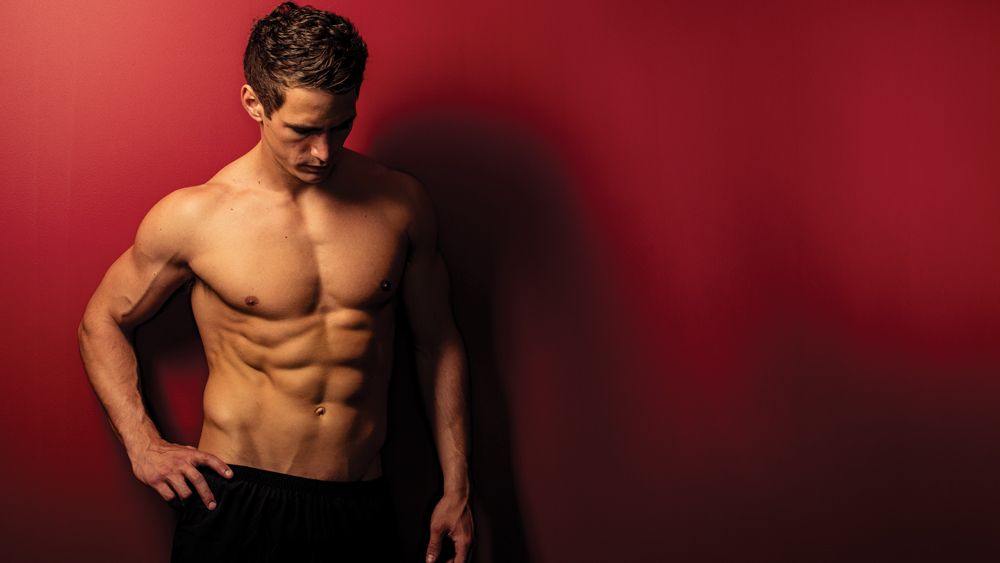Six-Pack “Rules” That Are Out Of Date
Science marches on, but these half-truths prevail. Read, re-evaluate, and revamp your abs training

1. “Sit-ups are still valid”
What it says There’s a guy at your gym who does 500 crunches a day and has an enviable six-pack. Obvious, right?
Why it’s wrong Chances are there’s more to his physique than just his abs routine… and he might be trading off for lower-back problems down the line. Endless reps of the traditional fixed-foot sit-up just aren’t that effective – and, according to research published in the British Journal Of Sports Medicine, can compound hip muscle imbalances and hyperextend your spine.
Your new approach “Your core has evolved to keep your body stable, so movements that focus on that should be your staples,” says Skorpions Gym trainer James Adamson. “The ab wheel roll-out is a great move: you’re forced to stay slow and controlled throughout the movement, using your core to resist collapsing.” Start with three sets of five and work up.
2. “A five-minute plank is impressive”
What it says You need a LOT of grit to tough this move out for anything more than two minutes, so five makes you the Plank King.
Why it’s wrong Eventually you’ll hit the point of diminishing returns, where you’re just becoming more efficient at the movement – and relaxing unnecessary muscle – rather than actually working the muscles you’re aiming to train. Great if you’re aiming to plank for longer, not so good if you want visible abs. Also, Plank King? The current world record is eight hours one minute – no, we don’t have that kind of time either.
Your new approach Upgrade your plank by switching to the super-plank version. “Bring your elbows forwards and close together, press your feet and heels together, and brace your glutes and abs,” says Adamson. “If you can hold it for more than 30 seconds, you aren’t trying hard enough.”
3. “Twisting crunches will work your side abs”
What it says It’s not all about the rectus abdominis, bro, so target your oblique muscles (your side abs) by adding a twist at the top of your crunches.
Get the Coach Newsletter
Sign up for workout ideas, training advice, reviews of the latest gear and more.
Why it’s wrong In a study published in the journal Medicine And Science In Sports And Exercise, twisting crunches were no more effective at working the obliques than sit-ups – and put excessive force on the lower lumbar spine.
Your new approach “Again, you should train your obliques to resist movement,” says Adamson. “The offset loaded carry is a good example of a move that will get it done. Carry a kettlebell in one hand, or at your shoulder, and resist as it tries to pull you off-balance.”
4. “You don’t need targeted abs training”
What it says Squats, deadlifts and overhead pressing tax your core from almost every angle. If you’re doing them heavy enough, there’s no need for a separate core workout.
Why it’s wrong OK, there’s some truth to this one. In testing under lab conditions, compound movements can sometimes outperform sit-ups and crunches for muscle activation. If all you want is reasonable core strength, they might be enough. But if you want more than that? Nope.
Your new approach “Tackle abs training like any other muscle group,” says Adamson. “With moderate-to-low reps, planned progression, and extra resistance if you need it.” Do include some chin-ups, though: they’re better than even weighted crunches for working your core.
See related
- How To Get A Six-Pack
- Six-Pack Diet: 27 Foods That Will Help To Reveal Your Abs
- Lose Weight With This Four-Week Meal Plan For Men
5. “You need weight to build abs”
What it says This is new-school myth-making. Now that the 100-crunch crowd has been shown the door, there’s a craze for adding plates to traditional exercises – from loading up a plank to heavy weighted crunches.
Why it’s wrong Done smartly, adding weight can help, but it can also encourage injury – putting a brace of 20kg plates on your lower back isn’t a good idea for many people – and it’s entirely possible to make existing bodyweight moves more intense with proper attention to form.
Your new approach Before you add weight, slow the moves down and get them right. “A good example is the Russian twist,” says Adamson. “Rather than yanking yourself from side to side, keep your arms forward and parallel, feet slightly off the floor and twist slowly at the waist from side to side.” Downside: it’s not pleasant.
6. “You can target belly fat”
What it says The advice to eat certain foods or do abs moves that “target” the fat in your gut area is misguided. That said, this one is a half-truth: there’s some evidence that addressing your levels of stress hormone cortisol can stop excess fat storage, and the belly is where it’s normally deposited first.
Why it’s wrong Unless you’re already in the body fat sweet spot – sub-12% is the goal – advanced methods of targeting fat won’t do anything to reveal even your upper abs, let alone the lot.
Your new approach “Target fat loss with nutrition first, training next and more complex approaches last of all,” says Precision Nutrition coach Jess Wolny. If stress is an issue, target it with better-quality sleep by switching off your mobile an hour before bed.
Coach is a health and fitness title. This byline is used for posting sponsored content, book extracts and the like. It is also used as a placeholder for articles published a long time ago when the original author is unclear. You can find out more about this publication and find the contact details of the editorial team on the About Us page.

